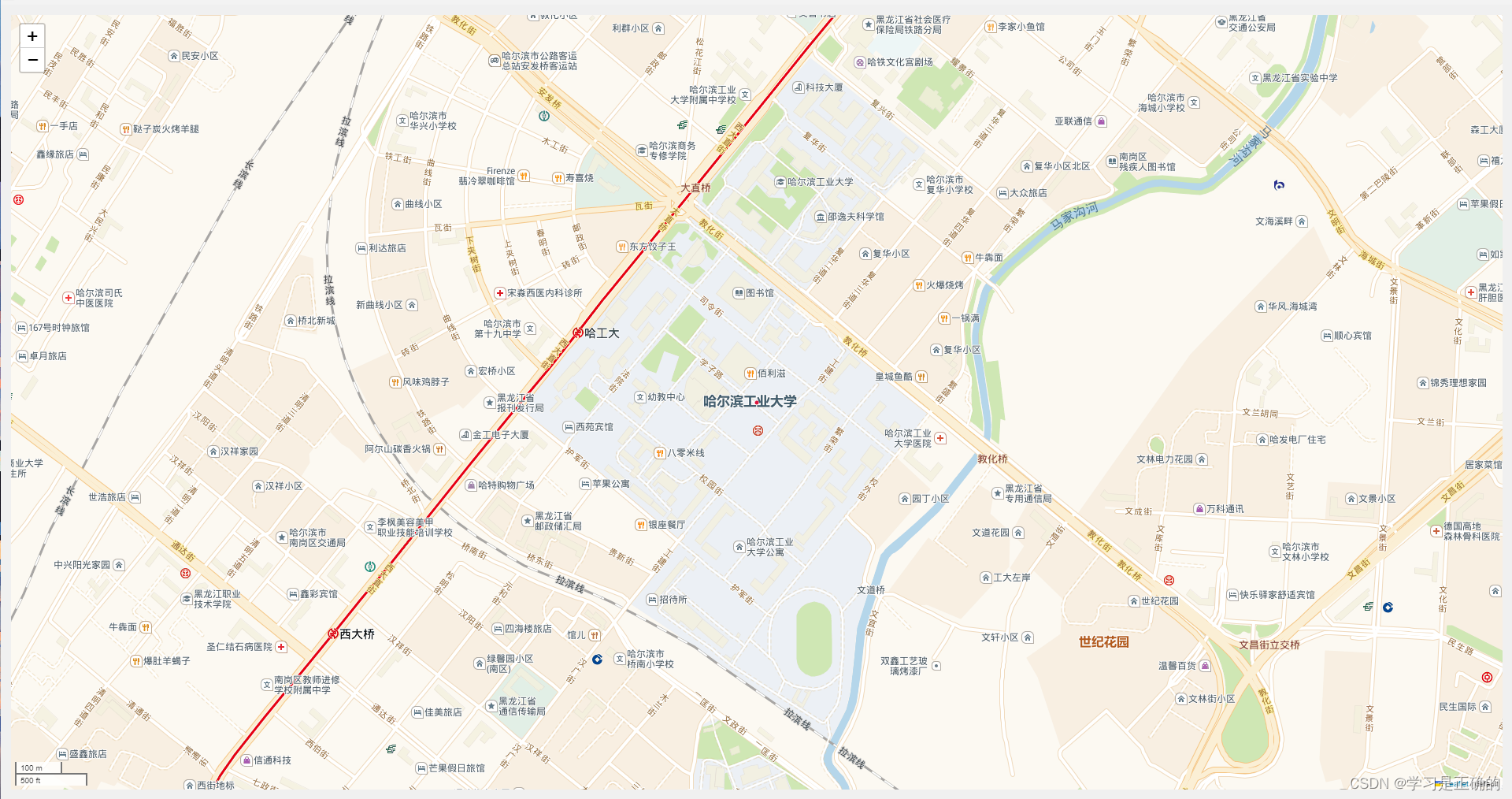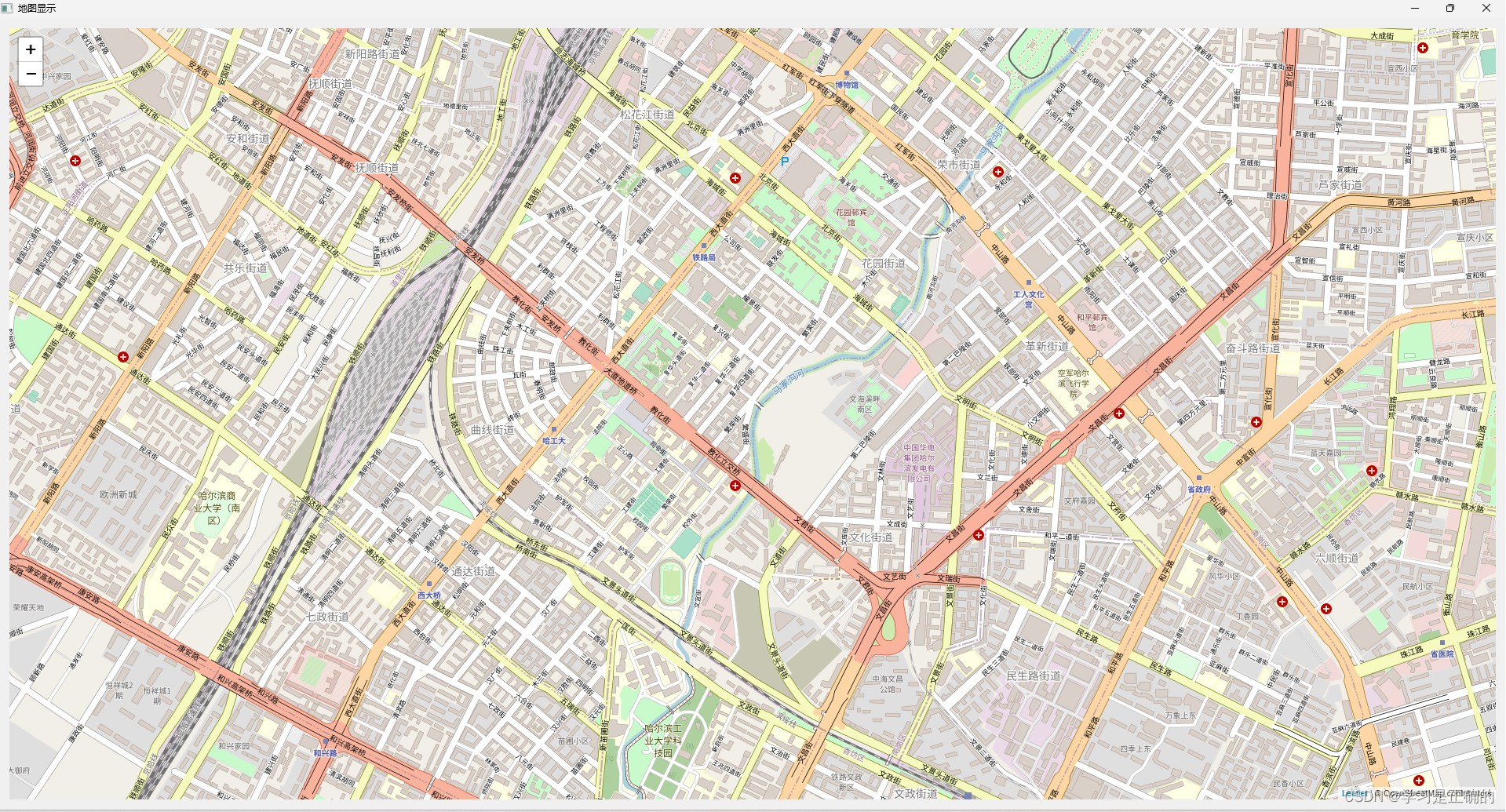PyQt地图
一、问题引入
最近在做一个PyQt的地图实时轨迹绘制的项目,在这个过程中遇到过一些问题,比如PyQt如何加载除地图,如何在地图上根据经纬度变化面画轨迹等等。
二、加载地图
首先就是地图加载的问题,我前后采用了两种方法来加载地图,包括离线文件方式加载和动态渲染方式加载。
1.离线文件方式加载地图
离线文件方式的思路就是首先保存一份地图的离线文件,然后再在PyQt的窗口中加载出来。
from PyQt5.QtCore import *
from PyQt5.QtWidgets import *
from PyQt5.QtWebEngineWidgets import *
import sys
import os
import folium
class MainWindow(QMainWindow):
def __init__(self):
super(QMainWindow, self).__init__()
self.setWindowTitle('地图显示')
self.resize(1000, 640)
layout = QVBoxLayout()
self.qwebengine = QWebEngineView(self)
layout.addWidget(self.qwebengine)
self.container = QWidget(self)
self.container.setLayout(layout)
self.setCentralWidget(self.container)
self.generate_map()
def generate_map(self):
location = [126.632628,45.743215]
location.reverse()
# 调用高德地图http://webrd02.is.autonavi.com/appmaptile?lang=zh_cn&size=1&scale=1&style=7&x={x}&y={y}&z={z}
Map = folium.Map(location,
zoom_start=16,
control_scale=True,
tiles='http://webrd02.is.autonavi.com/appmaptile?lang=zh_cn&size=1&scale=1&style=7&x={x}&y={y}&z={z}',
attr='default')
Map.add_child(folium.LatLngPopup()) # 显示鼠标点击点经纬度
Map.add_child(folium.ClickForMarker(popup='Waypoint')) # 将鼠标点击点添加到地图上
# 标记一个实心圆
folium.CircleMarker(
location,
radius=1,
popup='popup',
color='#DC143C', # 圈的颜色
fill=True,
fill_color='#6495E' # 填充颜色
).add_to(Map)
Map.save("map.html")
# 在QWebEngineView中加载网址
path = "file:\\" + os.getcwd() + "\\map.html"
path = path.replace('\\', '/')
self.qwebengine.load(QUrl(path))
if __name__ == '__main__':
app = QApplication(sys.argv)
win = MainWindow()
win.show()
sys.exit(app.exec_())
运行结果

这种方法的思路很简单,但是过程比较繁琐,而且不好对地图添加轨迹,因为每次都要重新加载离线文件,会产生很明显的地图刷新效果,影响观感。
所以有另一种思路:不保存离线地图文件,直接将地图文件数据导入到PyQt的窗口进行显示,后续再利用JavaScrip语句操作地图数据,进行轨迹绘制,能很好的解决离线刷新的问题。
2.动态渲染方式
动态渲染的方式是利用leaflet和JavaScrip语句进行的,需要先下载leafle相关文件,下载地址https://leafletjs.com/,下载完成后需要将文件夹内部的文件复制到项目里面。
import sys
from PyQt5.QtWidgets import QApplication, QMainWindow, QVBoxLayout, QWidget
from PyQt5.QtWebEngineWidgets import QWebEngineView
from PyQt5.QtCore import QUrl
class RealTimeMapApp(QMainWindow):
def __init__(self):
super(RealTimeMapApp, self).__init__()
self.setWindowTitle('地图显示')
self.resize(800, 600)
layout = QVBoxLayout()
self.qwebengine = QWebEngineView(self)
layout.addWidget(self.qwebengine)
self.container = QWidget(self)
self.container.setLayout(layout)
self.setCentralWidget(self.container)
self.qwebengine.setHtml(self.generate_map_html(), baseUrl=QUrl.fromLocalFile('.'))
def generate_map_html(self):
html = """
<!DOCTYPE html>
<html>
<head>
<meta charset="utf-8" />
<title>Real-time Map</title>
<style>
body, html, #map {
height: 100%;
margin: 0;
}
</style>
<!-- 引入 Leaflet 的 CSS 和 JavaScript 文件 -->
<link rel="stylesheet" href="https://unpkg.com/[email protected]/dist/leaflet.css">
<script src="https://unpkg.com/[email protected]/dist/leaflet.js"></script>
</head>
<body>
<div id="map" style="width: 100%; height: 100vh;"></div>
<script>
var mymap = L.map('map').setView([45.743215, 126.632628], 15);
L.tileLayer('https://{s}.tile.openstreetmap.org/{z}/{x}/{y}.png', {
attribution: '© OpenStreetMap contributors'
}).addTo(mymap);
</script>
</body>
</html>
"""
return html
if __name__ == '__main__':
app = QApplication(sys.argv)
win = RealTimeMapApp()
win.show()
sys.exit(app.exec_())
运行结果:

三、轨迹绘制
加载完图片后就需要进行轨迹绘制了,因为采用第一种方式会有刷新的效果,因此这里不再展示第一种方式的轨迹绘制效果。
利用第二种方式加载完成地图后,根据经纬度列表,就能在地图上画出轨迹图了。这里采用随机路径的方法进行绘制,如果手头上有路径经纬度数据,也可以用手头的数据进行路径轨迹绘制。
import sys
from PyQt5.QtWidgets import QApplication, QMainWindow, QVBoxLayout, QWidget
from PyQt5.QtWebEngineWidgets import QWebEngineView
from PyQt5.QtCore import QTimer, QUrl
import random
class RealTimeMapApp(QMainWindow):
def __init__(self):
super(RealTimeMapApp, self).__init__()
self.setWindowTitle('实时地图轨迹')
self.resize(800, 600)
layout = QVBoxLayout()
self.qwebengine = QWebEngineView(self)
layout.addWidget(self.qwebengine)
self.container = QWidget(self)
self.container.setLayout(layout)
self.setCentralWidget(self.container)
self.qwebengine.setHtml(self.generate_map_html(), baseUrl=QUrl.fromLocalFile('.'))
self.new_point = None
self.old_point = None
self.old_label = None # 用于保存旧点的经纬度标签对象
self.timer = QTimer(self)
self.timer.timeout.connect(self.update_map)
self.timer.start(1000) # 每秒更新一次地图
def generate_map_html(self):
html = """
<!DOCTYPE html>
<html>
<head>
<meta charset="utf-8" />
<title>Real-time Map</title>
<style>
body, html, #map {
height: 100%;
margin: 0;
}
</style>
<!-- 引入 Leaflet 的 CSS 和 JavaScript 文件 -->
<link rel="stylesheet" href="https://unpkg.com/[email protected]/dist/leaflet.css">
<script src="https://unpkg.com/[email protected]/dist/leaflet.js"></script>
</head>
<body>
<div id="map" style="width: 100%; height: 100vh;"></div>
<script>
var mymap = L.map('map').setView([45.743215, 126.632628], 14);
L.tileLayer('https://{s}.tile.openstreetmap.org/{z}/{x}/{y}.png', {
attribution: '© OpenStreetMap contributors'
}).addTo(mymap);
var pathMarkers = L.layerGroup().addTo(mymap);
var newMarkerIcon = L.icon({
iconUrl: 'C:/Users/22285/Desktop/test_python/leaflet/images/marker-icon.png', // 用于新的轨迹点(注意修改路径)
iconSize: [16, 16],
iconAnchor: [8, 8]
});
var oldMarkerOptions = {
radius: 5,
fillColor: 'blue',
color: 'blue',
fillOpacity: 1
};
var oldMarker; // 声明在外部以持久保存旧点的图标对象
function addPoint(lat, lng, isNew) {
var latlng = new L.LatLng(lat, lng);
if (isNew) {
if (oldMarker) {
pathMarkers.removeLayer(oldMarker); // 删除旧点的图标
mymap.removeLayer(oldLabel); // 删除旧点的经纬度标签
}
oldMarker = L.marker(latlng, { icon: newMarkerIcon }).addTo(pathMarkers);
var label = L.divIcon({
className: 'label',
html: `<div style="white-space: nowrap; margin-left: 1em;">Lat: ${lat.toFixed(7)} Lng: ${lng.toFixed(7)}</div>`
});
var newLabel = L.marker(latlng, { icon: label }).addTo(pathMarkers);
oldLabel = newLabel; // 保存旧点的经纬度标签对象
} else {
var marker = L.circleMarker(latlng, oldMarkerOptions).addTo(pathMarkers);
}
mymap.panTo(latlng);
}
</script>
</body>
</html>
"""
return html
def update_map(self):
new_point = [45.743215 + random.uniform(-0.01, 0.01), 126.632628 + random.uniform(-0.01, 0.01)]
if self.new_point is not None:
self.old_point = self.new_point # 保存上一个新点的坐标
self.new_point = new_point
# 使用 JavaScript 添加新的轨迹点到地图上x
javascript = f"addPoint({
new_point[0]}, {
new_point[1]}, true);"
self.qwebengine.page().runJavaScript(javascript)
if self.old_point is not None:
# 使用 JavaScript 添加旧的轨迹点到地图上,并连接成线
lineCoordinates = "[[" + f"{
self.old_point[0]},{
self.old_point[1]}], [{
new_point[0]},{
new_point[1]}]]"
javascript = f"var line = L.polyline({
lineCoordinates}, {
{color: 'red'}}).addTo(mymap);"
self.qwebengine.page().runJavaScript(javascript)
if __name__ == '__main__':
app = QApplication(sys.argv)
win = RealTimeMapApp()
win.show()
sys.exit(app.exec_())
注意:图标路径需修改。
运行结果:
PyQt地图轨迹绘制
注意:第二种加载方式需要外网。